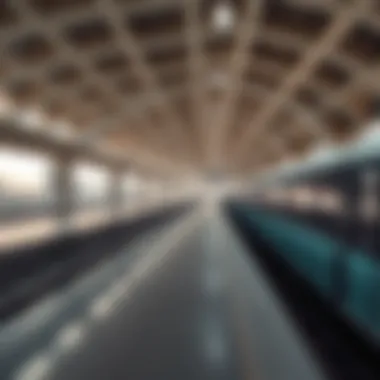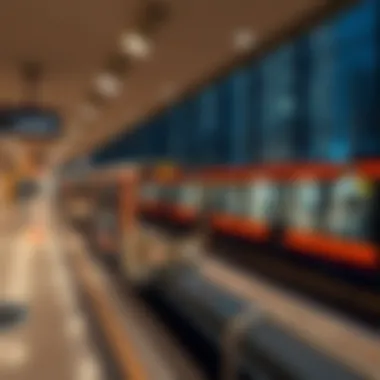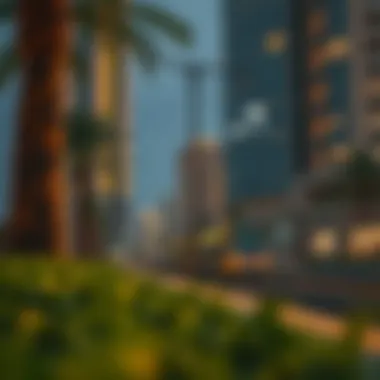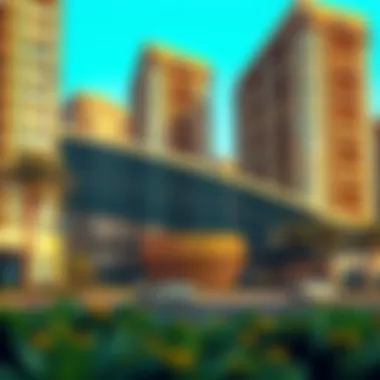Exploring the Jaddaf Metro: Dubai's Urban Connectivity


Intro
As Dubai continues to evolve into a global metropolis, the city's metro system stands as a vital cog in its urban infrastructure. At the heart of this system lies the Jaddaf Metro station, which is more than just a transit point. It plays a crucial role in connecting diverse neighborhoods, boosting accessibility, and stimulating real estate developments. The intricate relationship between efficient public transport and urban planning can't be overstated, especially in a modern city like Dubai where innovation meets tradition.
Within this article, we will explore how the Jaddaf Metro station not only enhances the daily commuting experience but also contributes significantly to local economies and urban living standards. The interplay between transportation and real estate is vital for investors and property managers alike, as understanding these dynamics can inform better investment strategies and development planning.
By diving deep into the Jaddaf Metro's strategic significance, design traits, and broader influences on the urban fabric, we can appreciate its role as a linchpin of Dubai's societal structure. Let's take a closer look at the investment opportunities that arise in its vicinity.
Overview of Dubai's Metro Network
The realm of urban transportation has been transformed significantly with the advent of Dubai's Metro Network. This system not only facilitates the daily commuting of thousands but also underscores the city’s commitment to modernity and efficiency. The Jaddaf Metro station, part of this network, plays a pivotal role in redefining mobility in the region.
At its core, the metro network is a response to the rapid urbanization seen in Dubai. It serves as the backbone for connecting diverse communities, reducing road congestion, and promoting a sustainable urban environment. The integration of advanced technology, such as automated trains and electronic ticketing systems, enhances user experience and decreases travel times considerably.
Historical Context
The roots of the Dubai Metro date back to the early 2000s, when the local government recognized the impending transportation challenges posed by fast population growth. Construction commenced in 2006, with the first line opening in 2009. This investment aimed not only to provide residents with faster transit options but also to position Dubai as a global tourism hub—a goal that remains ever relevant today.
Expansion Plans
Future Lines and Extensions
As cities expand, their transportation infrastructure must adapt accordingly. The future lines and extensions of Dubai's Metro Network are a testament to strategic urban planning. These expansions aim to enhance connectivity between various neighborhoods and vital commercial hubs, thereby improving accessibility across the city.
For instance, the proposed line extensions reaching into suburban areas are designed with users in mind. They will facilitate ease of access for a growing residential population and provide relief for congested main roads. Moreover, these lines emphasize integration with other transport modes, allowing for seamless transition between different travel methods. Promoting public transit as a convenient option can lead to a shift away from individual car use.
Projected Growth of Ridership
Analyzing the projected growth in ridership offers insights into the success of Dubai's Metro Network. Current trends suggest a sharp increase in the number of daily passengers relying on the metro for their commute, driven by demographic shifts and urban migration. With continuous advancements and services introduced, such as increased frequency and extended hours, it’s likely that ridership numbers will soar as potential users recognize the convenience and reliability of this mode of transport.
This rise in demand is not merely a statistical increment; it indicates a cultural shift within the society. More people are beginning to prefer public transportation, enhancing the sustainability of urban commuting. Thus, understanding the dynamics of ridership growth is integral to realizing the potential of infrastructure investments around Jaddaf Metro and beyond.
The efficacy of public transport systems, like the Dubai Metro, ultimately shapes the living experience of a city's residents.
In summary, the overview of Dubai's Metro network, particularly through the lens of Jaddaf, showcases the intersection of transportation, urban development, and community integration. As the city continues to expand, the metro remains a crucial component that aligns with the broader vision of a vibrant and interconnected urban landscape.
Preface to Jaddaf Metro Station
The Jaddaf Metro Station is more than just a stop on Dubai’s bustling metro line; it stands as a vital node in the city's broader urban infrastructure. This station is strategically placed, catering not only to the commuting needs of locals but also bridging gaps between varying neighborhoods. Given the rapid growth in Dubai, understanding the Jaddaf Metro Station’s features and its operational dynamics becomes essential for anyone navigating the city's transport landscape.
Station Features
Architectural Design
The architectural design of Jaddaf Metro Station combines functionality with modern aesthetics. This station features sleek, contemporary lines that reflect Dubai's progressive nature. The open-air design incorporates natural light, which is especially advantageous in a city famous for its sunshine. The unique placement of canopies and shading systems offers respite from the heat, enhancing the overall commuter experience.
The key characteristic of this design is its integration with the local environment; it doesn't just serve as a transport hub but as a part of the cultural fabric of the area. This thoughtful approach helps in promoting a sense of community among residents and visitors alike. Moreover, by using sustainable materials and energy-efficient building practices, Jaddaf Metro minimizes its carbon footprint, aligning with Dubai’s overarching sustainability goals.
The advantage of this unique architectural design is clear – it provides both aesthetic appeal and functional benefits. However, some may argue that the maintenance of such modern designs can be challenging, especially in a city known for its sandstorms and extreme weather.


Facilities and Amenities
Facilities and amenities at the Jaddaf Metro Station cater effectively to a wide range of commuters. A standout feature is the integration of retail spaces within the station. These shops and cafes offer convenience for passengers looking to grab a quick bite or indulge in some shopping before or after their commute.
Another noteworthy aspect is the availability of smart technology features. For instance, real-time information displays help passengers stay updated on train schedules. This is particularly beneficial for busy professionals and tourists who might be unfamiliar with the system.
The key characteristic of the amenities in Jaddaf Metro Station is the emphasis on passenger comfort and convenience. This user-centric approach ensures that the station meets the diverse needs of everyone who uses it. However, one downside to the amenities could be the potential for overcrowding during peak hours, impacting the overall experience.
Operational Details
Schedule and Frequency
The schedule and frequency of trains at Jaddaf Metro Station are designed to accommodate the heavy flow of daily commuters. With trains running every few minutes, particularly during peak hours, passengers enjoy a seamless transition to their destinations. This efficient scheduling not only lowers wait times but greatly enhances overall travel efficiency in Dubai.
An important trait is the regular service throughout the day, which ensures that even late-night commuters have reliable transport options. The predictability of this service contributes to reduced congestion on roads, as more people opt for public transport rather than personal vehicles, leading to smoother traffic flow.
However, some users may observe occasional delays during peak periods due to increased demand, a common challenge for any urban transit system.
Accessibility Options
Jaddaf Metro Station prides itself on being accessible for everyone, including those with disabilities. The layout of the station is designed to facilitate easy navigation for individuals with mobility challenges. Elevators and ramps are strategically placed, ensuring that no one is left behind.
Additionally, clear signage in multiple languages aids not only locals but also international visitors in finding their way. The inclusion of auditory signals helps visually impaired passengers navigate the station easily, further contributing to its inclusive design philosophy.
Despite these thoughtful measures, accessibility can sometimes be hindered during busy periods, when the flow of foot traffic might become overwhelming. Nevertheless, the commitment to providing a welcoming environment for all commuters is evident.
"The Jaddaf Metro Station represents not just progress in transit, but also in urban connectivity and inclusivity."
In summary, the Jaddaf Metro Station stands as a pivotal element in the overall infrastructure of Dubai's metro system, blending architectural ingenuity with unparalleled facilities and operational efficiency. Understanding these elements provides insight into how the metro not only serves as a transportation solution but as a facilitator for community cohesion and urban development.
Connecting Communities: Jaddaf and Surrounding Areas
Dubai’s Jaddaf Metro Station is not just a stop on a rail line but a dynamic portal interlinking various neighborhoods, weaving them together like threads in a tapestry. The significance of focusing on how it connects communities cannot be overstated. It enhances accessibility, encourages localized economic growth, and cultivates a vibrant community atmosphere around it.
Neighborhood Integration
The Cultural Landscape
The Jaddaf area is a melting pot of cultures, reflecting the multicultural fabric of Dubai. Its rich cultural landscape is highlighted by art galleries, museums, and cultural centers, which foster artistic expression and community pride. The neighborhood hosts annual events that celebrate its diversity, allowing residents and visitors alike to engage and appreciate the myriad cultures coexisting here. This aspect makes Jaddaf a significant draw for families and tourists who seek a deeper understanding of Dubai's heritage.
One characteristic that stands out about Jaddaf is its calming vibe compared to the bustling downtown areas. Walking through the tree-lined streets, you might stumble across the Dubai Design District, which not only showcases local talents but also provides space for innovative workshops. This unique feature gives residents and visitors an opportunity to immerse themselves in the local arts while supporting budding artists. However, one disadvantage could be the limited commercial eyes when compared to larger commercial areas nearby, sometimes making the region seem quieter than others on the list of must-visit locations.
Commercial Developments
The importance of commercial developments around the Jaddaf Metro cannot be ignored. The rise of cafes, retail outlets, and offices is reshaping economic prospects in the area. These ventures are crucial for boosting local employment and generating foot traffic, not only for businesses but also for public transport usage. The presence of these establishments can enhance the overall quality of life, offering convenience and a range of services to residents.
A standout feature of commercial developments in Jaddaf is their connection to local businesses, which often prioritize sustainability and community engagement. For instance, many new shops are designed to be eco-friendly and support locally sourced products, aligning with global sustainability goals. However, one must recognize the disadvantage that the rapid expansion can sometimes lead to congestion and a decline in the neighborhood's tranquil atmosphere, diluting the cultural purity that Jaddaf prides itself on.
Influence on Commuter Patterns
Shift in Transportation Preferences


The Jaddaf Metro has catalyzed a shift in transportation preferences across the region. With reliable transit options readily available, many commuters have traded in their cars for the convenience of public transportation. This decision not only reduces travel time but also fosters a sense of community. Public transport offers a chance for residents to engage with one another, creating social networks that enhance neighborhood cohesion.
Moreover, an intriguing feature of this shift is the rising interest in electric bicycles and scooters as supplementary modes of transportation. The integration of more bike-friendly infrastructure complements the metro system, improving accessibility. On the flip side, the downside includes the initial resistance from people accustomed to car travel, affecting overall adoption rates initially.
Environmental Impacts
The environmental impacts associated with the Jaddaf Metro are significant. With a focus on reducing carbon footprints, increased metro usage contributes to lesser vehicular traffic, leading to decreased emissions. As part of Dubai's wider vision to enhance sustainability, metro expansion aligns nicely with efforts in urban greening and pollution reduction.
A distinct feature of prioritizing the metro over other forms of transport is that it encourages a complete shift in urban planning towards walkable neighborhoods. This is beneficial because it creates green spaces and encourages healthier lifestyles through walking. But the downside remains: construction phases can be disruptive to the existing landscape, temporarily unsettling the neighborhoods it aims to improve.
Overall, the Jaddaf Metro station stands as a cornerstone, knitting together a diverse cultural landscape and generating a broad spectrum of socio-economic opportunities. As one delves deeper into its impact on local connectivity and urban growth, it becomes clear that this station does more than facilitate transport—it enhances the overall quality of life for those living and working in and around Jaddaf.
Real Estate Dynamics Near Jaddaf Metro
The Jaddaf Metro Station represents more than just a point on a map; it is a catalyst for real estate transformation in the surrounding areas. The connection the metro provides enhances accessibility, which, in turn, affects demand for both residential and commercial properties. This development is not just about constructing buildings but also about creating a community enriched by connectivity.
As these lines grow, investors and property developers find themselves looking at the Jaddaf area more closely. The proximity to the metro translates into heightened interest in property investments, surging demand, and, consequently, elevated property values. Hotspots like the Jaddaf Metro location are closely monitored by analysts, real estate agents, and potential buyers for signs of opportunity and growth.
Property Value Trends
The value of properties near the Jaddaf Metro has seen a steady increase. Factors like enhanced mobility, decreased commuting time, and the integration of commercial spaces contribute to this upward trend. Areas within walking distance of the metro tend to demand higher prices due to their attractiveness to potential buyers.
It's interesting to note how the market reacts to small changes. For example, a new café or boutique near the metro can uplift nearby property values substantially. A robust transportation hub like Jaddaf creates a ripple effect that can elevate the desirability of even previously overlooked neighborhoods.
Investment Opportunities
Residential Projects
Residential projects near Jaddaf Metro are becoming favorites among stakeholders. The unique selling point here lies in the blend of convenience and lifestyle. Developers are keen on creating mixed-use developments that combine living spaces with leisure and retail options. This integration ensures that homeowners have easy access to essential amenities, making it a lucrative proposition.
Furthermore, the ability to live within close reach of public transport facilities encourages urban living, appealing to younger professionals and families alike. However, one of the potential downsides could be initial high investment costs. While the location promises growth, early involvements may also coincide with ongoing construction, which might deter some buyers temporarily.
Commercial Real Estate
On the commercial end, Jaddaf presents a fertile ground for businesses. Shops, offices, and hospitality spaces benefit immensely from the flow of commuters. A key characteristic of commercial real estate in this area is its adaptability. Office spaces, co-working environments, and retail units are evolving to meet the needs of modern consumers, making it a popular choice for businesses of all sizes.
One might find unique attractions, such as themed restaurants and local boutiques, within the vicinity. The primary advantage here is quite clear; they can tap into a steady stream of pedestrians and commuters seeking convenience. Nevertheless, with such poses high competition. New businesses must innovate constantly to stand out among established ones.
Investors should keep an eye on the local dynamics to navigate these waters effectively. Diverse investment opportunities hold the promise of capital appreciation while also fostering a vibrant community atmosphere.
"The rise of Jaddaf Metro station has proven to be a game changer for the local real estate market, opening doors to untold opportunities."
With a deeper understanding of the evolving real estate landscape near Jaddaf Metro, stakeholders can better position themselves to take advantage of these developments. Keeping a finger on the pulse of trends and adapting to the shifting demographics will be crucial for long-term success.
Navigating the Jaddaf Metro Experience
When it comes to understanding the Jaddaf Metro station, one must take a closer look at how this facility reshapes the daily lives of commuters. It’s not just about hopping on a train; it’s about embracing a seamless integration of urban life and transportation. As more people lean towards public transit to escape the hustle and bustle of heavy traffic, the Jaddaf Metro has become a pivotal player in this shift.
Commuter Feedback


User Experience Insights
User experience is often seen as the backbone of any public transport system. With the Jaddaf Metro, commuters share that the station is remarkably well-designed for ease of use. The layout offers clear signage, making navigation straightforward regardless of linguistic barriers. Furthermore, features such as escalators and lifts enhance accessibility for those with mobility challenges or those traveling with children.
A key characteristic valued by commuters is the spaciousness of the station. Many have noted that the ample space reduces the feeling of being crammed, especially during peak hours. Moreover, the waiting areas are equipped with seating and are generally well-maintained, contributing to a pleasant commuting experience. This unique combination of accessibility and comfort makes it popular among both locals and tourists.
However, some users pointed out that during busy periods, the trains can get packed, making the experience a bit less idyllic. That said, the overall satisfaction with the user experience remains high, as the benefits tend to outweigh these minor inconveniences.
Suggestions for Improvement
Despite the commendable aspects of Jaddaf Metro, there’s always room for enhancement. One common suggestion among regular travelers is the need for enhanced digital integration. Many commuters expressed a desire for an app that tracks real-time train schedules and crowd levels. Such a feature could alleviate uncertainty and improve the overall travel experience.
Another area for improvement is the addition of more signage in multiple languages. While the current signage is indeed helpful, further translations may assist international visitors who might struggle with Arabic or English. Enhancing visual aids would help ensure everyone feels catered to, promoting inclusiveness and accessibility.
These suggestions highlight an ongoing conversation among users, stressing the importance of regular feedback and adaptation to meet the evolving demands of urban commuting.
Comparative Analysis with Other Stations
In conducting a comparative analysis between Jaddaf Metro and other stations within Dubai, one might find intriguing differences. For example, while Burj Khalifa station tends to attract a larger tourist crowd due to its proximity to major attractions, Jaddaf serves a more residential demographic. This essentially influences the types of services and the frequency of trains offered at each station.
Jaddaf’s focus on local community integration makes it an essential metro stop for those living in the surrounding neighborhoods. In contrast, other stations, like Dubai Mall, often see a higher footfall due to retail and entertainment activities. The diversity in Station profiles presents a fuller picture of how well the metro accommodates different needs across its extensive network.
This examination underscores the necessity of considering multiple factors when assessing the significance of Jaddaf Metro within Dubai's larger transit framework, ultimately revealing how stations cater to specific community needs and commuting scenarios.
Future Developments Related to Jaddaf Metro
The future of transportation in Dubai is inextricably linked to the Jaddaf Metro station. As urban growth accelerates, the station becomes more than just a hub of transit; it signifies the pioneering spirit of Dubai's infrastructure evolution. With ongoing investments and strategic projects slated for the coming years, understanding the developments surrounding the Jaddaf Metro is crucial for anyone interested in the city's urban landscape.
Upcoming Projects
Several key projects are on the horizon that directly impact the Jaddaf Metro. Among these is the expansion of the existing metro lines, which aims to increase connectivity across various neighborhoods in the city. Key details of these projects include:
- Enhanced Line Connections: Plans are underway to link Jaddaf Metro with both existing metro lines and new extensions, significantly speeding up travel times across the city.
- New Stations Development: Proposals for new stations within close proximity to Jaddaf are being considered, which will further improve access for residents and commuters.
- Integration with Other Transport Modes: There’s a push to synchronize metro services with buses and water taxis, making it easier for passengers to navigate the urban terrain effortlessly.
These initiatives reflect a vision that prioritizes mobility and accessibility, ensuring that the Jaddaf Metro continues to be a key player in urban transit.
Long-term Vision for Urban Transit
Sustainability Initiatives
One specific aspect gaining traction is the integration of sustainability initiatives into the Jaddaf Metro's future developments. This approach focuses on reducing emissions and promoting eco-friendly transit options. Notable characteristics of these initiatives include:
- Energy Efficiency: New technologies are being explored to lower energy consumption in metro operations, aiming for a greener urban footprint. This shifts public perception towards public transport as a more viable alternative.
- Green Infrastructure: Incorporating green spaces within transit facilities is a unique feature that enhances the visual appeal and overall user experience while contributing to biodiversity.
These sustainability efforts are beneficial for reducing environmental impact, primarily through reduced carbon emissions. They play a crucial role in making the Jaddaf Metro an attractive choice for both commuters and investors.
Technological Advancements
When considering technological advancements, the Jaddaf Metro is positioned to harness cutting-edge technologies that further refine the commuter experience. Key features of these advancements are:
- Smart Ticketing Systems: The introduction of digital ticketing will streamline the process, enabling a cashless and more efficient travel experience.
- Real-Time Tracking: Technology that offers real-time updates on train schedules empowers commuters to plan their travels more effectively, reducing wait times.
These advancements provide substantial advantages, enhancing the overall user experience while demonstrating a commitment to innovation in urban transit. Such approaches ensure that the Jaddaf Metro not only meets current transportation demands but also adapts to future challenges.
"The Jaddaf Metro isn’t just a transit solution; it’s a catalyst for urban development and sustainability in Dubai."
In summary, the trajectory of the Jaddaf Metro is poised for expansion and innovation, reflecting the city's ambition to remain at the forefront of urban development. Investors and property managers should keenly watch these developments as they are likely to influence property values and commuter patterns in the vicinity.



